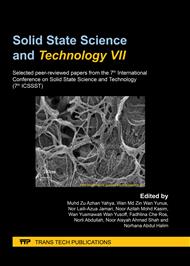p.195
p.202
p.208
p.217
p.227
p.233
p.241
p.251
p.257
In Vivo Toxicity Assessment of Nickel Zinc Carbon Nanotubes in a Living Host Model
Abstract:
Nickel zinc carbon nanotubes (NiZnCNT) has gained substantial interest among researchers lately due to its wide application in the field of biomedical fields. Nickel zinc (NiZn) is well known for its corrosion-resistant, microware and magnetic properties. On the other hand, carbon nanotube (CNT) is known for its application as biosensor and tissue engineering scaffolds. Despite the excellent properties and diverse applications, the toxicity profile of NiZnCNT remains poorly understood. In this study, the potential toxic effect of NiZnCNT to living organism was evaluated using a nematode Caenorhabditis elegans (C. elegans) model. Adult worms were exposed to NiZnCNT at 50 and 200 μg/mL, followed by the assessment of three physiological parameters, including the effect NiZnCNT on C. elegans feeding behavior, reproductive ability and the overall lifespan of the worms. No significant difference was noted between the feeding rate of worms treated with NiZnCNT at both concentrations and the control population (p>0.05). Furthermore, there was no reduction in the production of progenies in NiZnCNT-treated worms, proposing that the nanoparticles tested does not negatively affect the reproductive system of animal. The mean lifespan of worms for untreated control, 50 μg/mL and 200 μg/mL of NiZnCNT was 10.4, 9.7 and 8.9 days respectively and no significant difference was observed in statistical analysis (p>0.05). In conclusion, this study demonstrated in the context of whole organism that NiZnCNT did not possess harmful toxic effect to living system, at concentration up to 200 μg/mL. The results further support the use of this nanoparticle in the field of biomedicine.
Info:
Periodical:
Pages:
227-232
Citation:
Online since:
May 2021
Authors:
Keywords:
Price:
Сopyright:
© 2021 Trans Tech Publications Ltd. All Rights Reserved
Share:
Citation:


